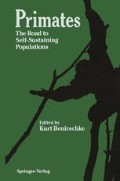Abstract
In countries of origin, nonhuman primates compete for space with rapidly expanding human populations. The loss of primary habitat as a result of the encroachment of humans on previously undeveloped areas is clearly the most serious threat to wild primates. As primate ranges become restricted, competition within species (as well as between species) intensifies. At critical levels, populations exceed carrying capacities by so much that they cannot be sustained, and rapid declines in numbers result. It is necessary that optimal sizes for wild preserves be identified if conservation in natural settings is to achieve long-term success.
Access this chapter
Tax calculation will be finalised at checkout
Purchases are for personal use only
Preview
Unable to display preview. Download preview PDF.
References
Anderson B, Erwin N, Flynn D, Lewis L, Erwin J (1977) Effects of short-term crowding on aggression in captive groups of pigtail monkeys (Macaca nemestrina). Aggress Behav 3: 33–46.
Dazey J, Kuyk K, Oswald M, Martenson J, Erwin J (1977) Effects of group composition on agonistic behavior of captive pigtail macaques, Macaca nemestrina. Amer J Phys Anthropol 46: 73–76.
Erwin J (1977) Factors influencing aggressive behavior and risk of trauma in the pigtail macaque (Macaca nemestrina). Lab Anim Sci 27: 541–547.
Erwin J (1979) Aggression in captive macaques: interaction of social and spatial factors. In: Erwin J, Maple TL, Mitchell G (eds) Captivity and behavior: primates in breeding colonies, laboratories, and zoos. Van Nostrand Reinhold, New York.
Erwin J, Flett M (1974) Responses of rhesus monkeys to reunion after long-term separation: cross-sex pairings. Psychol Rep 35: 171–174.
Erwin J, Maple TL, Willott J, Mitchell G (1974) Persistent peer attachments of rhesus monkeys: responses to reunion after two years of separation. Psychol Rep 34: 1179–1183.
Erwin J, Maple TL, Welles J (1975) Responses of rhesus monkeys to reunion: evidence for exclusive and persistent bonds between peers. Con temp Primatol Karger, Basel, pp 254–262.
Erwin J, Anderson B, Erwin N, Lewis L, Flynn D (1976) Aggression in captive groups of pigtail monkeys: effects of provision of cover. Percept Mot Skills 42: 319–324.
Erwin N, Erwin J (1976) Social density and aggression in captive groups of pigtail monkeys (Macaca nemestrina). Appl Anim Ethol 2: 265–269.
Lindburg D (1971) The rhesus monkey in North India: an ecological and behavioral study. In: Rosenblum L (ed) Primate behavior: developments in field and laboratory research, vol 2. Academic, New York, pp 1–106.
Neville MK (1966) A study of the free-ranging behavior of rhesus monkeys. Thesis, Harvard University, Cambridge.
Oswald M, Erwin J (1976) Control of intragroup aggression by male pigtail monkeys (Macaca nemestrina). Nature 262:686–688.
Sackett D, Oswald M, Erwin J (1975) Aggression among captive female pigtail monkeys in all-female and harem groups. J Biol Psychol 17:17–20.
Southwick C, Beg M, Siddiqui M (1965) Rhesus monkeys in North India. In: DeVore I (ed) Primate behavior: field studies of monkeys and apes. Holt, Rinehart and Winston, New York,p 111–159.
Swenson L, Bartlett L (1976) Experimental removal of female pigtail monkeys from groups. Paper presented Int Congr Primatol, Cambridge, England.
Editor information
Editors and Affiliations
Rights and permissions
Copyright information
© 1986 Springer-Verlag New York Inc.
About this paper
Cite this paper
Erwin, J. (1986). Environments for Captive Propagation of Primates: Interaction of Social and Physical Factors. In: Benirschke, K. (eds) Primates. Proceedings in Life Sciences. Springer, New York, NY. https://doi.org/10.1007/978-1-4612-4918-4_22
Download citation
DOI: https://doi.org/10.1007/978-1-4612-4918-4_22
Publisher Name: Springer, New York, NY
Print ISBN: 978-1-4612-9360-6
Online ISBN: 978-1-4612-4918-4
eBook Packages: Springer Book Archive

